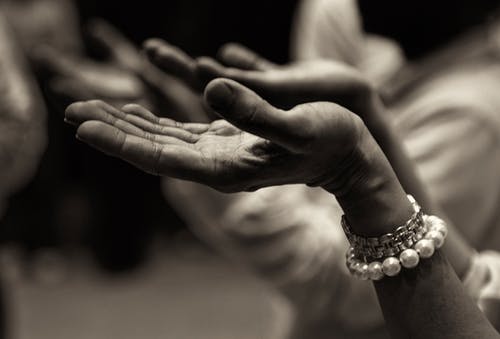Welcome, Feelings: Praying Through the Full Range of Emotions
Like so many people, I have been on an emotional roller coaster since March. Coming to terms with the pandemic and its ripple effects has mirrored aspects of the grieving process: denial, bargaining, acceptance, meaning making. In the United States, more have died from coronavirus than the total population of my hometown of Billings, MT. My brain and my heart have trouble digesting that more than 250,000 lives have been lost in the United States during this pandemic. In the same timeframe, I have lost my mother-in-law, my stepbrother, and my uncle. I learned my job is soon to end. And these bigger losses have been punctuated by smaller ones: school bus rides and physical classrooms for my children, hugging friends , working out at the YMCA, and holiday gatherings with grandparents.
All of these losses are difficult to abide. Even more so while we lack the tools and rituals to honor and endure them as we might usually. Funerals postponed indefinitely. Zoom goodbye parties for colleagues. Feeling disconnected from our usual sources of support. Parents supporting their children’s education while somehow trying to do their jobs.
A Litany of Lament
I am holding these personal and shared losses alongside my fear and anger about the extreme disfunction in our politics, especially at the national level. Furthering my sense of loss, I recently wrestled through a disagreement on social media with acquaintances from high school and early childhood class. I realized during our exchange that we weren’t really disagreeing at the level of values or policy so much, but at the level of reality itself. It became clear during the back-and-forth that we did not share an understanding of the world in which we live. My personal exchange and the inability to really speak to one another is a microcosm of what is happening to our national political discourse. I am not sure I have words for this realization, but it is something like despair.
All this amounts to a litany of lament. I offer it not because my situation is particularly unique or difficult during this time, but because it is the landscape of my life. This is the real context in which any spiritual practice that I undertake must take place. I am hungry for practices that meet me where I am at and offer me some form of (even small) transformation.
Practicing the Welcoming Prayer
One practice that I have found especially helpful over the last several months is the Welcoming Prayer. The Welcoming Prayer is a simple (but not easy) practice of letting yourself begin to notice and accept what you are feeling. You welcome it prayerfully; then you let it go.
These are the three steps of the Welcoming Prayer as I was taught them:
1. Feel and sink into what you are experiencing in this moment.
2. Welcome what you are experiencing in this moment in your body as an opportunity to consent to the Divine Indwelling.
3. Let go of your desire for security, affection, control and embrace this moment as it is.
I was skeptical when I first encountered the Welcoming Prayer. Welcoming is certainly not my instinctive response to difficulty, sadness, pain, or anger. Rather, I want to resist whatever is wrong, to push back, to resolve. I wasn’t sure I wanted to just welcome all feelings and experiences. And I questioned whether acceptance was in fact always a laudable goal. There are many situations that I believe require a response that is quite the opposite of acceptance.
At the same time, these months have left me really wanting to experience a different way to interact with my own emotional life. I need a practice that helps be more calm and thoughtful even when I am sad, tired, or angry, because I have been sad, tired, and angry much of the time. I was willing to try the practice – at least long enough to see if it could help me respond more deliberately in difficult situations.
The Welcoming Prayer was developed by Mary Mrozowski, one of the founders of Contemplative Outreach as an accompanying and supporting a practice to Centering Prayer, a prayer that usually involves silence and stillness. The Welcoming Prayer, in contrast, is intended to be done almost anywhere, and fairly quickly, if needed. Mrozowski said she drew wisdom from the 17th century teaching of Jean-Pierre de Caussade’s, from Fr. Thomas Keating’s teaching, as well as from her own lived experience.
Here are some of my reflections on the three parts of the Welcoming Prayer, at least as I have come to experience the process:
Feel and sink into what you are experiencing this moment.
When I do scan of my body (usually more effective with eyes closed, but I sometimes do it with my eyes open when I am in public). I try to simply notice whatever sensations I feel in my body. Where is there tension? How is my breathing? Sometimes it takes me a little while to identify what I am actually feeling. Sometimes I do not even have words to describe what I am feeling. That is ok. I still try to sink into it. This body scan is an important part of welcoming our feelings because our emotions live in our bodies and affect our whole bodies.
Welcome what you are experiencing this moment in your body as an opportunity to consent to the Divine Indwelling.
This is so much easier said than done. This is not just noticing but accepting and welcoming. I don’t always want to welcome what I am feeling. I may be jealous in a petty way or begrudgingly angry or sad in a way that is likely to last for a while. My instinct is to push those challenging feelings aside. These feelings are uncomfortable and even embarrassing sometimes. However, when we pause long enough to try to welcome what we are experiencing and to welcome God’s presence inside even our most uncomfortable experiences, this practice allows us to practice incarnation. God is present with us, even in our most complex and inarticulate emotional states. God is right there even then. Especially then.
Let go of your desire for security, affection, control and accept this moment as it is.
As human beings, most of our actions involve a desire for security, affection, or control. These are natural human instincts. Understandably, we seek a sense of security in our lives and of course we need affection from others. And we want some sense that our actions matter in the world and affect the direction of our lives. At first, I really wrestled with why I would want to let go of the need for security, affection, and control. But, I have come to understand that the kind of security at which I am often grasping is a fantasy. And while affection is certainly a necessary part of human relationships, I cannot base my decisions on what will earn me approval from others. And if a global pandemic teaches us nothing else, it is that there are so, so many things out of our control.
It is worth nothing that this process allows me to accept what is happening momentarily. This is not at all the same thing as passively enduring all that is wrong or unjust in the world. Rather, it is the humble acknowledgement that as much as we might dislike what is happening, it is indeed actually happening. Acknowledging reality does not necessarily mean that we support what is happening, nor does it mean that we never take action. Assessing and accepting a situation gives us a chance to pause and then act from a more centered place. I am coming to understand that this works on a small scale with minor interactions in our daily lives and on a larger scale of trying to impact our wider communities. Accept. Pause. Respond.
Embracing Joy, Along with Everything Else
While I admit that I use this practice primarily when I am experiencing more difficult emotions, I have occasionally found it to be just as effective in helping me digest and accept joy. Surprisingly, joy can be just as challenging to sink into as sadness or anger. For example, I recently read an email from a friend--offering me confidence-boosting feedback. On a whim, I decided to try to sink into my feelings afterward. When I scanned my body, I felt light and able to breathe easily. I felt connection and reassurance that my work matters to others. I was surprised and delighted by the simple, raw joy I was experiencing. We are all seeking joy, but too often when we actually find it, we have trouble staying with it. In some ways, we might be more comfortable with anger, sadness or irritation. Joy is vulnerable. In order to really experience it, joy requires us to accept that it is actually happening, to trust that the moment will hold us, and to believe that we deserve to experience it. Our desire for security, affection, and control not only prevents us from being present to grief, anger, and sorrow, those desires can also get in the way of our joy.
Over the past several months, I have practiced the Welcoming Prayer in manageable moments in hopes that I might be better prepared to welcome my feelings when bigger challenges arise. I am learning that the Welcoming Prayer is helpful for the full range of emotions: fear, anxiety, frustration, vulnerability, skepticism, and, yes, even joy.
As we continue to endure our natural reactions to the state of our world--a seemingly endless pandemic and an uncertain future still unfolding, I am especially grateful for this prayer practice. The Welcoming Prayer is portable and simple and practical. It has helped me engage a full range of unbidden feelings. Deep anxiety. Real fear. Compassion for those who are most likely to get sick and those who have the fewest resources among us. Vulnerability, because I realize how much we really depend on one another and how little control I really have. Anger at poor leadership decisions that are costing lives. Isolation. Gratitude. Joy in small moments with my children. Irritation at those same children just five minutes later.
The practice of the Welcoming Prayer is one way to listen to what our bodies are telling us rather than just pushing that information aside. It is one way to actively welcome the Divine Presence, if only for a moment. And it is one way to let go of our desire for security, affection, and control, if only for a moment… with the hope that we might pause long enough to better align our actions with greater love, compassion, and healing, one moment at a time.






